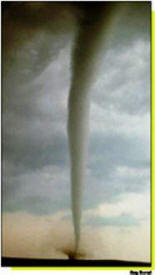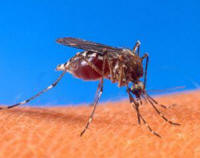

To send a message to an author, click on the author's name at the end of the article.
This Month in Ag Connection | Ag Connection - Other Issues Online

March was a stormy month for many regions of Missouri. If mother nature dealt you a casualty loss resulting from the stormy weather - you may have some options in claiming the casualty loss on your tax return.
Following the March 11-12 series of tornado outbreaks, the 36 counties listed below were declared eligible for federal disaster assistance. If you suffered a casualty loss in any of these counties you have the option of claiming the loss on your 2006 income tax return or claiming the loss on your prior year tax return (2005). If you have already filed your 2005 tax return, you can file an amended return. Filing an amended return is not extremely difficult and does not substantially increase the risk of an audit.
Claiming the casualty loss on the prior year tax return allows taxpayers who suffered losses to realize the resulting tax recovery in a more timely manner.
(Author: Parman Green, Ag Business Specialist)
The following counties were declared disaster counties as a result of the March storms: Bates, Benton, Boone, Carroll, Cass, Cedar, Christian, Cooper, Greene, Henry, Hickory, Howard, Iron, Jefferson, Johnson, Lawrence, Lincoln, Mississippi, Monroe, Montgomery, Morgan, New Madrid, Newton, Perry, Pettis, Phelps, Putnam, Randolph, Saline, Scott, St. Clair, Ste. Genevieve, Taney, Vernon, Webster and Wright.
This Month in Ag Connection | Ag Connection - Other Issues Online
The recent devastating tornadoes that hit Missouri have caused many Missourians to take a closer look at their vulnerability to nature's wrath and to make better preparations for surviving future storms. Having a shelter or a 'safe room' built into or near the home can help protect families from injury or death caused by the dangerous forces of extreme winds.
All of Missouri is in Wind Zone IV, meaning wind gusts from severe storms can exceed 250 miles per hour. The number of recorded tornadoes is 6-15 per 1,000 square miles for much of the state. Combining these factors places the entire state at a high risk level that warrants a shelter as the preferred method of protection.
The shelter or safe room should be free of clutter and readily accessible from all parts of the house. It must be located in a flood-free area, well-anchored to resist overturning and uplift, and the walls, roof and door made strong enough to resist penetration by wind-borne missiles.
Common house construction techniques based on "minimum" building codes generally don't provide adequate protection. Most Missouri counties do not have even these minimum building codes.
To help homeowners and builders design and build shelters that do withstand extreme wind speeds, the Federal Emergency Management Agency has a 28-page booklet entitled FEMA 320 "Taking Shelter from the Storm: Building a Safe Room Inside Your House", which includes 16 pages of construction plans and cost estimates. A free copy can be obtained by calling FEMA toll-free at 1-888-565-3896 or visit their web site at: http://www.fema.gov/safe-rooms
Also, "Storm Cellar" (USDA Plan #6209) is a one-page construction blueprint for building two sizes of in-ground concrete storm cellars (8 ft. x 16 ft. and 5 ft. x 10 ft.). The plan is available for $3 plus shipping and handling through the University of Missouri's Agricultural Engineering Department by calling toll-free 1-800-995-8503.
Whether you build a shelter or not, two important steps you can take to protect your family are to prepare an emergency plan for dealing with disaster situations and put together an emergency supply kit for home, business and each vehicle. The American Red Cross has a disaster supply list at the following site: http://www.redcross.org/prepare
(Author: Bob Schultheis, Natural Resource Engineer, University of Missouri Extension)
This Month in Ag Connection | Ag Connection - Other Issues Online
Cattle, sheep and goats may soon have another grazing animal join them on the farm. Overcrowding the pasture won't be an issue. That's because, unlike other livestock, these new animals do their grazing in a pond, not a pasture. In the summer of 2005, University of Missouri researchers launched a preliminary three-month study to assess the feasibility of paddlefish "ranching" for the state's pond owners.

"Missouri ranks second behind Texas in the number of private impoundments (ponds)", said Bob Pierce, MU Extension fish and wildlife specialist. "For many pond owners, paddlefish could create a profit base from a resource currently not in use on their farms." Pierce, MU fisheries professor Rob Hayward and agricultural economist Joe Parcell are examining the ecology and economics of placing the prehistoric-looking big river fish in ponds.
The idea is not a new one. Jim Kahrs, owner of Osage Catfisheries Inc., has raised paddlefish for 30 years. He has contracted with Missouri pond owners to grow the fish. Currently, the Osage Beach, MO hatchery is the only U.S. company with an international permit to sell paddlefish flesh, caviar and live eggs. Kahrs donated about 90, 15-month-old paddlefish for the MU pilot study. The forearm-length fish were stocked in two university research farm ponds in early July.
"We'd like to validate some of the things we think we have proven through our operation", Kahrs said. "I think Missouri has the opportunity to become the paddlefish capital of the world."
"Paddlefish, which commonly exceed five feet in length and 60 pounds in weight, primarily feed on microscopic aquatic animals called zooplankton", Hayward said. "We want to see what, if any, effect these fish have on the composition and density of zooplankton in a pond. This is especially important because zooplankton are the key food source for other larval fishes", he said. "There are some concerns that stocking paddlefish in a pond can negatively impact the populations of sportfish such as bass, bluegill and crappie."
MU fisheries and wildlife undergraduate researchers Rebecca Wright of St. Louis and Tiffanie Hamilton of Des Moines, Iowa, have collected pre- and post-stocking water samples from the MU farm ponds and a separate control pond. The samples will allow the researchers to determine changes to the zooplankton communities.
"Eventually, we'd like to develop a model for paddlefish stocking", Pierce said. "Even if we find that there are impacts to the zooplankton community, those impacts may not be perceived as negative for landowners not interested in rearing sportfish."
The researchers currently are in the process of submitting proposals for additional funding to investigate opportunities for paddlefish production in Missouri ponds. Hayward said that paddlefish are rapid growers, able to put on a pound or two per year, and even more as they age. The fish also grow faster in ponds and other reservoirs because zooplankton densities are higher than in native river habitats.
A primitive species, the fish's skeleton is made entirely of cartilage, much like that of a shark. Only two paddlefish species exist worldwide - one in the Yangtze Valley in China and one in North America. The fish is native to the Mississippi, Missouri and Osage River basins in Missouri.
(The sources for this article are: Rob Hayward, Associate Professor of Fisheries and Wildlife (573) 882-2353; Bob Pierce, MU Extension Assistant Professor of Fisheries and Wildlife (573) 882-4337; and Jim Kahrs, Osage Catfisheries Inc. (573) 348-2305.)
This Month in Ag Connection | Ag Connection - Other Issues Online
There is interest in these rather expensive backyard toys/equipment/safety devices. Several points need to be considered. The prices rage from just under $100 to around $1400. The use of such contraptions appears to be so much more important since the arrival of West Nile Virus (WNV). Although, the problems associated with WMV appear to be a little less important the last couple of years.

The thing mosquito traps have in common is carbon dioxide (CO2). Mosquitoes are attracted to CO2 given off by animals as they breathe. Their ability to track an animal's CO2 rivals or exceeds a shark's ability to sense and track blood in the water. Propane is a typical source for making CO2, although some use CO2 tanks or CO2 generating chemicals. The attraction to heat is an additional benefit from the burning of propane. Motion, is another but largely ignored mosquito attractant.
Another often used attractant is odor. Octonol, 1-Octen-3-ol (a derivative of gasses produced in the rumen of cows), is commonly used to increase the effectiveness of traps. One University study commented that dirty gym socks work almost as well as fancy chemical attractants.
Actually trapping the mosquito is the final part. Traps use fans to suck them in and the capture is in bags or baskets, on sticky surfaces and some even electrically zap the mosquitoes. The more expensive traps may use the heat to produce electricity to power the fan. Such units can be put anywhere. Others are limited by the length of extension cords and available outlets. A few are passive using sticky surfaces and chemical attractants. They can also be put almost anywhere.
All traps require regular maintenance to operate properly. Propane tanks, odor producers or CO2 producers need refilling or replacement. Capture bags or baskets need cleaning or replacement. Sticky trap surfaces need replacement and even electrical zapping grids may need cleaning. In addition, there will be other trap components that will certainly need care.
Mosquitoes are not attracted to light. Light traps (bug zappers) should not be considered as a substitute for a mosquito trap. Some mosquito traps do have lights. These may allow those traps to catch other night flying insects. Studies have shown light traps may attract more insects than they are able to catch or kill. This is evidently also true for mosquito traps. Instructions may say the traps may need to be operated 24/7 for several weeks to significantly impact mosquito numbers. Read about the trap to know how it must be operated and maintained.
Finally, there are a number of different mosquito species involved in spreading WNV. Some mosquito traps are more efficient in catching mosquitoes than others. Not all mosquito traps are equally efficient in catching all mosquito species. Mosquito species and numbers vary across the United States, Missouri, between counties and even backyards. Any serious attempt to manage mosquitoes must include other methods like repellents, insecticides, protective clothing, barriers like screens or nets, and especially mosquito breeding site management.
The sources of information for this article include Richard Houseman, MU Assistant Professor of Entomology (573) 882-7181, Jim Jarman, Agronomy Specialist (573) 642-0755 and numerous articles and web sites. Contact local University of Missouri Extension Centers for further information.
This Month in Ag Connection | Ag Connection - Other Issues Online
Publishing Information
Ag Connection is published monthly for Northeast and Central areas of Missouri producers and is supported by the University of Missouri Extension, the Missouri Agricultural Experiment Station, and the MU College of Agriculture, Food and Natural Resources. Managing Editor: Mary Sobba.